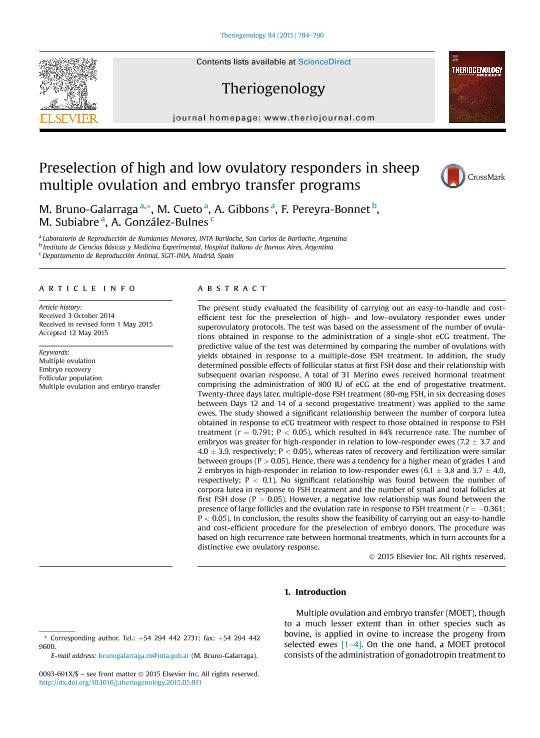Mostrar el registro sencillo del ítem
dc.contributor.author
Bruno Gallaraga, M.
dc.contributor.author
Cueto, M.
dc.contributor.author
Gibbons, A.
dc.contributor.author
Pereyra Bonnet, Federico Alberto

dc.contributor.author
Subiabre, M.
dc.contributor.author
Gonzalez Bulnes, A.
dc.date.available
2018-04-12T17:26:28Z
dc.date.issued
2015-09
dc.identifier.citation
Bruno Gallaraga, M.; Cueto, M.; Gibbons, A.; Pereyra Bonnet, Federico Alberto; Subiabre, M.; et al.; Preselection of high and low ovulatory responders in sheep multiple ovulation and embryo transfer programs; Elsevier Science Inc; Theriogenology; 84; 5; 9-2015; 784-790
dc.identifier.issn
0093-691X
dc.identifier.uri
http://hdl.handle.net/11336/41861
dc.description.abstract
The present study evaluated the feasibility of carrying out an easy-to-handle and cost-efficient test for the preselection of high– and low–ovulatory responder ewes under superovulatory protocols. The test was based on the assessment of the number of ovulations obtained in response to the administration of a single-shot eCG treatment. The predictive value of the test was determined by comparing the number of ovulations with yields obtained in response to a multiple-dose FSH treatment. In addition, the study determined possible effects of follicular status at first FSH dose and their relationship with subsequent ovarian response. A total of 31 Merino ewes received hormonal treatment comprising the administration of 800 IU of eCG at the end of progestative treatment. Twenty-three days later, multiple-dose FSH treatment (80-mg FSH, in six decreasing doses between Days 12 and 14 of a second progestative treatment) was applied to the same ewes. The study showed a significant relationship between the number of corpora lutea obtained in response to eCG treatment with respect to those obtained in response to FSH treatment (r = 0.791; P < 0.05), which resulted in 84% recurrence rate. The number of embryos was greater for high-responder in relation to low-responder ewes (7.2 ± 3.7 and 4.0 ± 3.9, respectively; P < 0.05), whereas rates of recovery and fertilization were similar between groups (P > 0.05). Hence, there was a tendency for a higher mean of grades 1 and 2 embryos in high-responder in relation to low-responder ewes (6.1 ± 3.8 and 3.7 ± 4.0, respectively; P < 0.1). No significant relationship was found between the number of corpora lutea in response to FSH treatment and the number of small and total follicles at first FSH dose (P > 0.05). However, a negative low relationship was found between the presence of large follicles and the ovulation rate in response to FSH treatment (r = −0.361; P < 0.05). In conclusion, the results show the feasibility of carrying out an easy-to-handle and cost-efficient procedure for the preselection of embryo donors. The procedure was based on high recurrence rate between hormonal treatments, which in turn accounts for a distinctive ewe ovulatory response.
dc.format
application/pdf
dc.language.iso
eng
dc.publisher
Elsevier Science Inc

dc.rights
info:eu-repo/semantics/openAccess
dc.rights.uri
https://creativecommons.org/licenses/by-nc-nd/2.5/ar/
dc.subject
In Vitro Fertilization
dc.subject
Ewe
dc.subject
Pregnancy
dc.subject
Moet
dc.subject.classification
Otras Biotecnología Agropecuaria

dc.subject.classification
Biotecnología Agropecuaria

dc.subject.classification
CIENCIAS AGRÍCOLAS

dc.title
Preselection of high and low ovulatory responders in sheep multiple ovulation and embryo transfer programs
dc.type
info:eu-repo/semantics/article
dc.type
info:ar-repo/semantics/artículo
dc.type
info:eu-repo/semantics/publishedVersion
dc.date.updated
2018-04-12T14:31:40Z
dc.journal.volume
84
dc.journal.number
5
dc.journal.pagination
784-790
dc.journal.pais
Estados Unidos

dc.description.fil
Fil: Bruno Gallaraga, M.. Instituto Nacional de Tecnología Agropecuaria. Centro Regional Patagonia Norte. Estación Experimental Agropecuaria San Carlos de Bariloche; Argentina
dc.description.fil
Fil: Cueto, M.. Instituto Nacional de Tecnología Agropecuaria. Centro Regional Patagonia Norte. Estación Experimental Agropecuaria San Carlos de Bariloche; Argentina
dc.description.fil
Fil: Gibbons, A.. Instituto Nacional de Tecnología Agropecuaria. Centro Regional Patagonia Norte. Estación Experimental Agropecuaria San Carlos de Bariloche; Argentina
dc.description.fil
Fil: Pereyra Bonnet, Federico Alberto. Hospital Italiano. Instituto de Ciencias Básicas y Medicina Experimental; Argentina. Consejo Nacional de Investigaciones Científicas y Técnicas; Argentina
dc.description.fil
Fil: Subiabre, M.. Instituto Nacional de Tecnología Agropecuaria. Centro Regional Patagonia Norte. Estación Experimental Agropecuaria San Carlos de Bariloche; Argentina
dc.description.fil
Fil: Gonzalez Bulnes, A.. Instituto Nacional de Investigación y Tecnología Agraria y Alimentaria; España
dc.journal.title
Theriogenology

dc.relation.alternativeid
info:eu-repo/semantics/altIdentifier/doi/http://dx.doi.org/10.1016/j.theriogenology.2015.05.011
dc.relation.alternativeid
info:eu-repo/semantics/altIdentifier/url/https://www.sciencedirect.com/science/article/pii/S0093691X15002575
Archivos asociados
